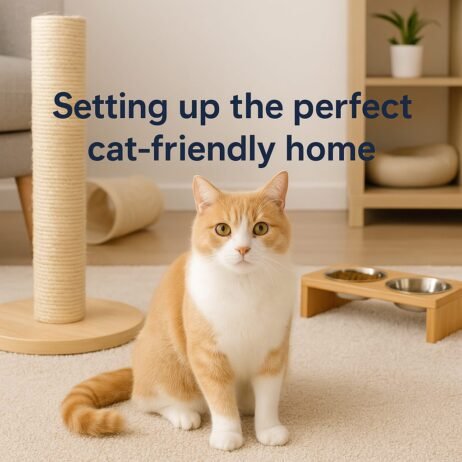Setting up the perfect cat-friendly home
- 23 September 2025
- BuyAPet Editorial Team
- All Cats, Cats and Dogs
Setting up the perfect cat-friendly home
Create a safe, happy space your cat will love—without sacrificing your home’s style. Here’s a practical, vet-informed UK guide with room-by-room tips, a toxic plant list, a printable-friendly checklist, and quick FAQs.
Home zoning basics
Think in zones: eat, toilet, sleep, play, and scratch. Keep feeding areas far from litter (ideally in separate rooms). Offer at least one quiet retreat per cat, above floor level if possible.
- Multi-cat rule: one litter tray per cat plus one.
- Traffic flow: avoid dead-ends; provide two routes in/out of key rooms.
- Windows: create safe window perches to watch the world without escaping.
Litter tray setup
- Location: quiet, low-traffic, away from washing machines/boilers (noise matters).
- Size: at least 1.5× your cat’s body length (nose to base of tail).
- Substrate: most cats prefer fine, unscented clumping litter; keep depth 5–7 cm.
- Cleaning: scoop 1–2× daily, full refresh weekly; use enzyme cleaner for accidents.
- Privacy: covered boxes can trap smells—trial open vs covered to see preference.
Scratching & vertical space
Scratching is normal and healthy. Provide sturdy posts taller than your cat’s full stretch (usually 70–80 cm) and at least one horizontal scratcher.
- Place posts near nap spots and entrances (where cats like to “scent mark”).
- Use catnip or silvervine to attract, and reward when they use it.
- Add shelves or a tree to create up—vertical territory reduces stress, especially in flats.
Feeding & water
- Separate stations: keep water away from food; many cats drink more this way.
- Shallow bowls: wide, whisker-friendly dishes reduce stress.
- Puzzle feeders: turn meals into enrichment; slow intake and add fun.
- Multi-cat: individual bowls, spaced apart to avoid guarding.
Enrichment & play
- Daily 10–15 min interactive play (wand toys), ending with a small treat—mimic hunt-eat-sleep.
- Rotate toys weekly to keep novelty. Store out of sight between sessions.
- Offer safe hideouts (boxes, tunnels) and comfy high perches with non-slip surfaces.
UK household safety
Common hazards: hot hobs, open windows/balconies, thread/string toys, lilies, antifreeze, human meds, essential oils, and rodenticide bait.
- Windows & balconies: install secure screens; use tilt-and-turn cautiously.
- Washing machines: always check drums before use; keep doors closed.
- Cables: tidy with trunking or covers; provide chew-safe alternatives.
Toxic plants (quick list)
Keep these out of reach: lilies (Lilium/Hemerocallis), sago palm, dieffenbachia, pothos, philodendron, cyclamen, foxglove, yew, mistletoe. Safer picks: spider plant, areca palm, calathea.
One-page setup checklist
- ✔ Separate zones for litter, feeding, rest, and play.
- ✔ Litter: quiet spot, right size, 5–7 cm depth, scoop daily.
- ✔ Scratching: one tall + one horizontal; place near nap spots.
- ✔ Water away from food; consider a fountain or multiple bowls.
- ✔ Daily interactive play; rotate toys weekly.
- ✔ Secure windows/balconies; hide cables; plant-proof your space.
- ✔ Provide at least one high retreat and one cosy hideout.
FAQs
Where should I put the litter tray in a small flat?
Choose the quietest spot away from the kitchen and washing machine—often a hallway corner or bathroom. Ensure easy escape routes and avoid doorways that slam.
How do I stop sofa scratching?
Place a tall, sturdy post directly beside the target area; cover the sofa edge with a temporary protector; reward scratching on the post; use catnip/silvervine to attract.
Are cat grass and herbs safe?
Yes—cat grass (wheat/barley) and herbs like catnip are fine. Avoid toxic plants like lilies and sago palm. Introduce slowly to prevent tummy upsets.
What’s the best flooring if I’m renovating?
Scratch-resistant LVT or sealed wood is practical; add washable rugs for traction and comfort. Avoid looped carpets that can snag claws.
